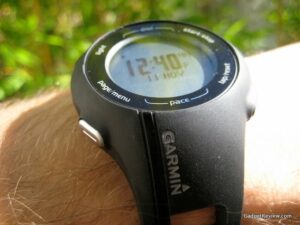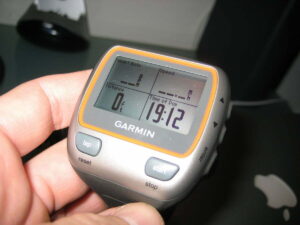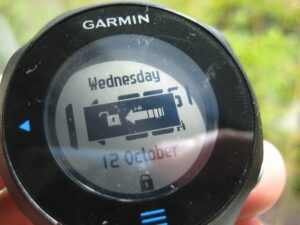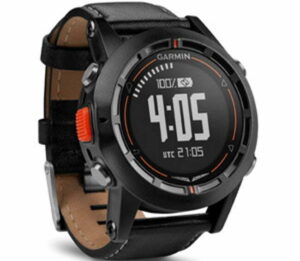I don’t fancy myself much of an athlete. By the very nature of my job I spend a good chunk of my day sitting. Fortunately, the space I’m now in offers standing desks. A treadmill desk would be less practical, but more beneficial to my over all health. But for now, until I can afford to travel the world, exercise everyday and eat like a God, I’ll have to settle for my regular routine. Speaking of traveling the world, this Garmin D2 pilot watch comes in pretty handy if you’re a pilot. My routine usually involves jogging, lifting weights, biking, and a few days of Kung Fu per week – you’d know this if you’ve read any of my other reviews related to fitness products. And, if you want more watches to choose from, then read our best running watches list.
Unfortunately, I’m remiss when it comes to keeping track of my exercise. Then again, I’m not in it to lose weight. It’s cliché, but it makes me feel good, provides some added confidence, and most importantly gives me some energy I wouldn’t otherwise have.
Nevertheless, it’s an interesting prospect when you do start to track your calories burned, miles completed, and heart rate. The added info provides a bit more motivation and could very well be just what I need to push my exercise routine to the next level. For a fitness watch with a 200-hour battery life, then read our Suunto Ambit 3 running watch review.
Enter the Suunto Ambit2 S, the company’s newest GPS fitness watch. Launched in tandem was the Ambit2 – a watch that boasts the same design, GPS tracking and a variety of additional sensors – the Ambit2s packs in GPS, an accelerometer, altimeter, and ANT+ wireless technology.
For those seeking a bit more info about their routines, you can pick up a bike or foot pod for some added cash. While they’re not necessary – the Ambit2 S can perform a number of calculations to tell you speed, distance, location, and more – they add another layer of info and can supplant the GPS signal when it’s not available (e.g. running on a treadmill or running where GPS is spotty). If you want a great watch for athletes, then check out our Suunto Ambit3 vertical review.
Aesthetically the Ambit2 S sports a large face that by most accounts makes it both trendy and, pardon the cliché, manly. It comes in a variety of finishes. Suunto sent me their silver and black model, which I found practical since it blended in or complemented all of my clothing regardless of color.
Controlling the Suunto Ambit2 S comes by way of five buttons – two on the left and three on the right. Each button’s function is relatively straight forward, making the Ambit2 S easy to use directly out of the box. However, it took me a bit of trial and error to understand a few of the buttons “hidden” functionality, which is to say it’s not labeled on the face of the watch.
For instance, to start a new exercise you simply hit the Start/Stop button. Pretty self evident, right? But to exit an exercise you’ll need to hold down the Start/Stop button (after you pause the timer) where upon the screen will display a short circular countdown that indicates you’ll be leaving the exercise of choice. You’ll then need to hit the Next button to return to the main screen, which displays the time, date, battery life, and a few other options depending on what “view” you have it in – there is a View button that cycles through screen options depending on the mode you’re in.
 [box_tip]I highly recommend locking the Suunto Ambit2 S, as it has a tendency to start a timer or turn on the light if a button is knocked while placing it down. Ironically the lock button is shared with the Light button, so beware to complete the lock cycle by holding the button.[/box_tip]
[box_tip]I highly recommend locking the Suunto Ambit2 S, as it has a tendency to start a timer or turn on the light if a button is knocked while placing it down. Ironically the lock button is shared with the Light button, so beware to complete the lock cycle by holding the button.[/box_tip]
Included in the box with the Ambit2 S is a heart rate monitor. Like other watches of this ilk, the heart rate strap will send your heartbeat to the Ambit2 S, allowing you to track your BPM and calories burned. When a new exercise is started the watch will look for the monitor – this takes usually less than two seconds – and once connected will keep you abreast of your instant heart rate as well as your peak. This data can be viewed in a variety of formats (on a graph) and even be used to tell you your rate of recovery and goals.
If an outdoor exercise is activated, the heart rate monitor search screen will be followed by a GPS search screen. In my experience the Suunto Ambit2 S is exceptionally quick at locating a GPS signal. Sometimes it took less than 10 seconds, provided of course I was standing still. If on the move, such as a bicycle, or running, it can than take minutes – the same can be said if it’s cloudy or there is foliage over head. Nevertheless, it’s vastly faster than any of Garmin’s watches that I’ve tested.
Battery for the Ambit 2S is spec’d at 16 hours with GPS turned on. Unfortunately, I can’t speak to that, but needless to say, with the GPS activated, battery life is significantly reduced. That said, since I exercised about 4 times a week with the GPS enabled, I was able to get about a 1 to 1.5 weeks of total battery life before having to recharge. To do that, Suunto includes a USB cord with a special clip on the end with 4 contact points. It’s a bit awkward, but the pay off that it allows the watch to remain waterproof to 330 feet.
[box_tip]Before connecting the Suunto Ambit 2s to your computer, sign up for an account on Suunto’s website.[/box_tip]
Once the Ambit 2s is connected to a computer you can download your recorded data and upload it to their Moves Count website. There you can view your stats (BPM, distance, pace, speed, etc), plan/create a training program and interact with their community (you can pull up a map and view other Suunto owner’s stats if they so allow), and download a variety of apps that can be added to “sport modes”.
While the Ambit 2s may not be the most remarkable looking watch, it does boast a large face it that provides an agressive, manly look that is sure to complement any athlete and emphasize their willingness to participate in such extreme activity. That isn’t to say it isn’t suited for females, but given the watch’s rather large face, it might prove a bit too over bearing to smaller wrists. Nevertheless, it’s not encumbering to the wrist from a weight standpoint and the band didn’t have a tendency to pinch my arm hair, though I don’t have much compared to others.
Compared to Garmin’s offering, the Suunto, with the exception of being able to locate a GPS signal with exceptional speed, isn’t vastly different. Each company has their own flavor of UI, and while both are functional as well as usable, neither of them have crafted an iOS like level of simplicity and usability that enables any user to just get it. That said, battery life for Suunto’s Ambit 2s is exceptional and because of that it slightly edges out the last Garmin I reviewed.
Suunto’s app section is interesting, but I found installing apps and setting them up too cumbersome to use. It’s an interesting idea, but not one that I could get excited about. But it’s worth noting that I’m not an extreme athlete that engages in a vast array of sports. So that in mind, the app section makes the Ambit2 S applicable to a much wider range of athletes that can include, but isn’t limited to sailors, climbers, paddle boarders, trail runners – you name it and there is a setup for your sport. Sure, at the end of the day the core measurements (distance, heart rate, speed, etc) remain the same, but since they’re tailored accordingly the Suunto get’s high marks for versatility.
Bottom Line: Aside from the ability to locate a GPS single extremely fast, the Suunto Ambit2 S is a good all around sport watch that is suited for the mild to hardcore athlete.






![10 Best Smartwatches for Running in [year] 1 Best Smartwatch for Running](https://www.gadgetreview.dev/wp-content/uploads/Best-Smartwatch-for-Running-300x169.jpg)



